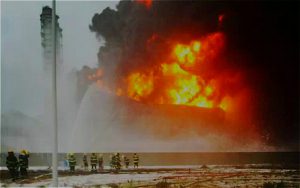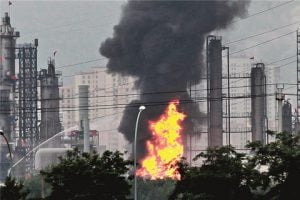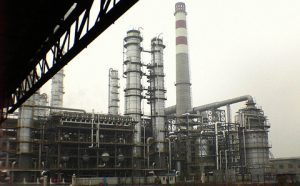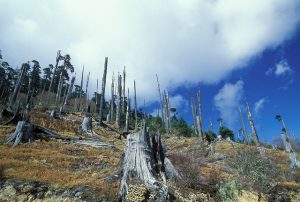A deadly blast at the northeastern city of Tianjin looks certain to shine a harsh light on how the production and storage of hazardous chemicals in China are regulated – amid growing consciousness of environmental issues among the public.
Two huge explosions at a chemicals storage warehouse in Tianjin’s sprawling port district on Wednesday have killed dozens of people, around a quarter of them firefighters, according to media reports at time of press. Around 700 are reported to be seriously injured.
Buildings and infrastructure were damaged over a wide radius, and it is not yet clear what kind of threat toxic materials have posed to human health amid reports that chemical warfare units are at the scene of the disaster.
Chinese media speculated that secondary explosions may have been fueled by materials including sodium cyanide, which is highly toxic; calcium carbide, which burns the skin; toluene diisocyanate, which harms the respiratory tract; and butanone, which can sting the eyes and nose if inhaled in large doses.
According to one report, sodium cyanide has been detected in Tianjin’s sewage system and emergency services are trying to remove 700 tonnes of the compound from the site.
The exact cause of the disaster isn’t yet known, and is the latest of a string of explosions and serious environmental incidents at chemical facilities on China’s heavily-industrialised east coast over the last decade. The scale of the Tianjin explosion – so big it was visible from space – is likely to stoke concerns that local officials are allowing too many dangerous facilities to operate without proper checks.
In common with many other fast-growing coastal cities in China, residential buildings and schools in Tianjin weren’t far from the port area, and scores of apartment blocks had windows and doors blown in by the blast.
Eyewitnesses said the fireball from the explosion reached a height of 20 storeys, incinerating thousands of cars and shipping containers stored at the port, parts of which resemble a war zone, video footage shows.
The China Youth Daily quoted an anonymous expert as saying the first explosion may have been caused by concentrated alcohol products, but added it is harder to identify what materials had caused the secondary blasts.
Tianjin’s city government said any pollutants released by the explosion are likely to have been blown out to sea by prevailing winds, while 12 emergency air quality measuring stations placed around the site showed levels of pollutants weren’t any higher than normal.
Despite reports that residents in Beijing, around 160 kilometres from Tianjin, had been told to stay indoors, official measurements of air quality in the capital did not register any effects from the explosion.
But some observers, such as Cheng Qian, an anti-pollution campaigner with Greenpeace, said air quality measurements do not include compounds that include cyanide.
Arrest
The warehouse at the centre of the explosion is owned by a private company, Ruihai International Logistics, which was founded in 2012 and trades in hazardous chemicals, handling one million tonnes of goods a year.
It also stores liquefied natural gas, flammable liquids, and toxic and corrosive products.
A Voice of China reporter met a Ruihui employee at the scene who had only escaped as he had gone out to buy food for six colleagues, and the journalist was told by the warehouse worker he had not received any training in handling hazardous materials.
A report on US online news site Quartz said a government inspection in 2013 reported five of the more than 4,300 containers on site were improperly encased (link in Chinese). A company official has been detained by the police, the People’s Daily reported.
Chemicals hub
Tianjin is northern China’s largest port, where the chemical sector is an integral part of the city’s economy.
In 2012 media reports drew attention that the Bohai Sea was being ‘encircled’ by the rapid growth of the chemical industry in Tianjin and neighbouring cities.
And across many parts of China, the media and general public have been asking questions about the level of disclosure and consultation in environmental impact assessments required from companies that store hazardous chemicals.
An environmental impact assessment for Ruihai, produced in 2013 by the Tianjin Academy of Environmental Protection Sciences, shows that the majority of products to be stored in the company’s warehouse were dangerous or flammable.
These presented environmental risks during transportation or storage, the assessment added, but it concluded that the risk of an accident was within acceptable limits.
As part of that report, 130 questionnaires were issued in the surrounding area; 100% of respondents said the site was suitable; around 52% were supportive of the proposed project’s measures for environmental protection; while the remainder expressed no opinion. However it is unclear who these respondents were.
Buffer zones
Since Wednesday’s explosion many local residents have told media they never saw any questionnaires. In many cases around China, the public have objected strongly to chemical plants near their homes.
One source who has played a leading role in Tianjin’s zoning decisions told the National Business Daily that growth in the chemical industry hadn’t originally been part of the plan for the Tianjin development zone – and that production plants are packed too closely together.
A professor from Xi’an University of Architecture and Technology said China’s rules on buffer zones between stores of hazardous materials and residential buildings needed to be made “much clearer”.







